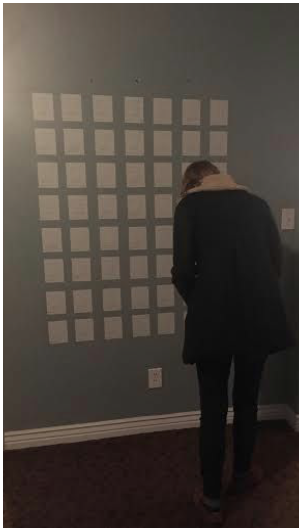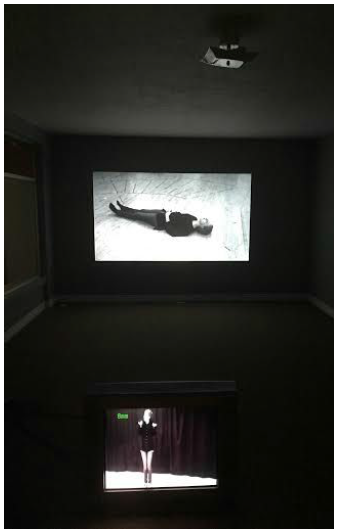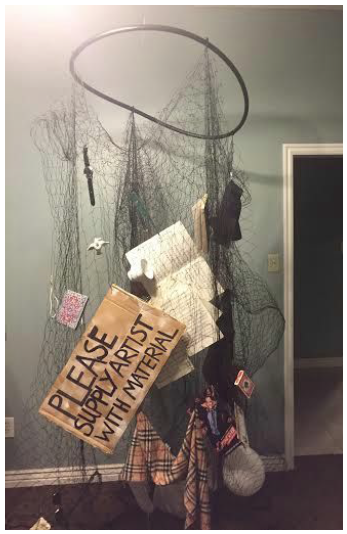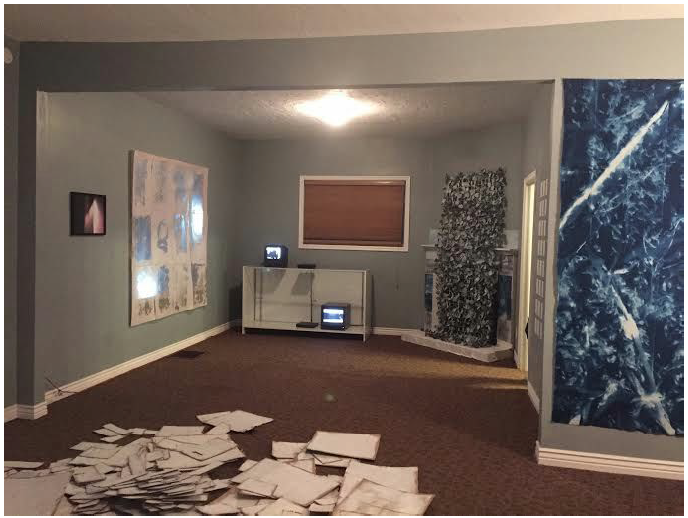Kristin Perkins and Lindsay Livinston, Theatre and Media Arts
With my collaborators, Pearl Corry and Aloe Corry, I constructed installation, video, and visual art pieces and presented this art as part of an exhibit entitled Striking the Set. Our initial objective was to use collaboration between theatre and visual artists in order to encourage healthy communication within our community. As our project evolved we encountered many problems. While our final product was something we could all be proud of, the setbacks in our process proved to be the greatest learning experience. The final exhibit was attended by more than sixty people and explored the theatrical elements present in visual art.
Challenges in the Process
We severely underestimated the challenges that would arise when artists from two different disciplines worked together. I am a theatre major with a love of the visual arts and the Corry sisters are visual artists with a love of theatre. However, we found that the way we think about process, audience, and even purpose, as informed by our two different disciplines, were almost unworkably different. The theatrical process, particularly as taught at Brigham Young University, favors creating a unifying thesis before aesthetic design. While this can be an approach used by visual artists, the creation of aesthetic beauty that speaks on an impulsive level is also seen as valuable. In part, this difference is the result of theatre’s inherent need for collaboration between an entire creative team, thus necessitating a grounding thesis. In contrast, visual arts are often created by a sole artist who can rely on subconscious creative instinct. Similarly, differences arose in our process as we considered the responsibility artists have to their audiences. I believe that the commerciality of theatre (and the larger budget usually required) results in theatre practitioners having a greater awareness of the audience’s expectations. The visual artist is both liberated and restricted by less of a concern for the audience’s experience. These difference were roadblocks in our process.
My analysis here is meant to not only describe challenges in our process but also to describe what we see as an opportunity for further research. I am interested in placing the challenges we faced into a larger context to understand how collaboration between artistic discipline can be facilitated.
Further Process
Our project evolved based on space constraints and our discussions surrounding communication. We struggled to find a gallery space, finally using the Echo Arts Center, a refurbished house in south Provo. The unique setting necessitated adapting our efforts in order to make art that interacted with a domestic space, rather than ignoring it. The space (which was larger than anticipated) also required us to consider expanding our project from one art installation done in collaboration, to an entire art show. We decided to separate work, while still keeping in close communication, so that we would each have independent art pieces that could constitute a full art show. We had many discussions about the nature of communication and our thoughts on how effective communication was possible. Towards the end of our project, we met regularly with our faculty advisor to discuss both ideas and logistics.
Final Product
Our final product was an art show produced off campus that explored the visual and theatrical arts, and the nature of communication between art forms. It was attended by more than sixty people including our faculty advisor, Professor Lindsay Livingston. While we worked in collaboration, often assisting each other both in discussing ideas and constructing installations, we each had specific art pieces. I installed a sculptural performance art piece that asked the audience to contribute to the construction of my identity. Pearl Corry worked on a series of photographs that blurred traditional theatrical spaces and recontextualized them, as well an installation that required the audience to walk over cardboard pieces, to their discomfort. Aloe Corry worked on several video pieces that demonstrated playfulness in a theatrical space that made the audience examine their own familiarity with theatrical constructions. Aloe Corry also completed an installation piece that interacted specifically with the house in which we had our show and repurposed a fireplace in order to demonstrate the artistic in the everyday.
Our separate art pieces worked together as informed by our many discussions on art and communication. In the end, we are all proud of our work and grateful for this amazing opportunity.
All images are provided by Kristin Perkins, Pearl Corry, and Aloe Corry and depict Striking the Set, an art show.




